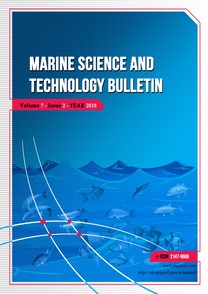Occurrence of the rabbitfish (Chimaera monstrosa Linnaeus, 1758) in the deep seas of Northern Cyprus, Mediterranean Sea
Rabbitfish (Chimaera monstrosa, Linnaeus 1758), which is a deep-sea holocephalan mostly seen between 200-1000 m in depth. The specimen of C. monstrosa was caught in the deep-seas of Northern Cyprus by a commercial bottom trawler from Turkey. The depth of sampling area is between 456 and 690 m. Species description fulfilled with the help of morphological features and metric measurements. The specimen was preserved in 4% formaldehyde and deposited in the Museum of the Systematic, Faculty of Fisheries, Mersin University, (Catalogue number: MEUFC-19-11-103).
Keywords:
Rabbit fish, Chimaera monstrosa, Northern Cyprus,
___
- Ali, M. (2003). Biosystematic and economical study of cartilaginous fish (Chondrichthyes) in Syrian Sea waters (eastern Mediterranean). Ph.D. Thesis. University of Tishreen, Lattakia, Syria.
- Bergstad, O. A., Wik, Å. D. & Hildre. (2003). Predator-prey relationships and food sources of the Skagerrak deep-water fish assemblage. Journal of Northwest Atlantic Fishery Science, 31: 1665-180. https://doi.org/10.2960/J.v31.a12
- Bilecenoğlu, M., Kaya, M., Cihangir, B. & Çiçek, E. (2014). An updated checklist of the marine fishes of Turkey. Turkish Journal of Zoology, 38(6): 901-929. https://doi.org/10.3906/zoo-1405-60
- Calis, E., Jackson, E. H., Nolan, C. P. & Jeal, F. (2005). Preliminary age and growth estimates of the rabbitfish, Chimaera monstrosa, with implications for future resource management. Journal of Northwest Atlantic Fishery Science, 35: 15–26. https://doi.org/10.2960/J.v35.m501
- Dalyan, C. (2010). Deniz biyoçeşitliliği. TÜBİTAK Bilim ve Teknik, 516: 56–59 (in Turkish).
- Didier, D. A., Kemper, J. M. & Ebert, D. A. (2012). Phylogeny, Biology and Classification of Extant Holocephalans, p. 97-122. In: Carrier, J. C., Musick, J.A., Heithaus, M. R. (eds.), Biology of Sharks and Their Relatives. 2nd ed. CRC Press: Bota Racon, FL, USA. 666 p.
- Eronat, E. G. T. (2016). Feeding ecology and trophic level of Chimaera monstrosa Linnaeus, 1758 (Holocephali: Chimaeridae) in the Eastern Mediterranean. Zoology in the Middle East, 62(1): 51–57. https://doi.org/10.1080/09397140.2015.1132560
- Geldiay, R. (1969). Izmir Körfezinin başlıca balıkları ve muhtemel invasionları. Ege Üniversitesi Fen Fakültesi Monografileri: İzmir, Turkey. 135 pp (in Turkish).
- Gillis, J. A., Rawlinson, K. A., Bell, J., Lyon, W. S., Baker, C. V. H. & Shubin, N. H. (2011). Holocephalan embryos provide evidence for gill arch appendage reduction and opercular evolution in cartilaginous fishes. Proceedings of the National Academy of Sciences, 108(4): 1507–1512. https://doi.org/10.1073/pnas.1012968108
- Jordan, D. S. & Snyder, J. O. (2011). A list of fishes collected in Japan by Keinosuke Otaki, and by the United States steamer Albatross, with descriptions of fourteen new species. Proceedings of the United States National Museum, 23(1213): 335–380. https://doi.org/10.5479/si.00963801.23-1213.335
- Kemper, J. M., Ebert, D. A., Compagno, L. J. V. & Didier, D. A. (2010a). Chimaera notafricana sp. nov. (Chondrichthyes: Chimaeriformes: Chimaeridae), a new species of chimaera from southern Africa. Zootaxa, 2532(1): 55–63. https://doi.org/10.11646/zootaxa.2532.1.2
- Kemper, J. M., Ebert, D. A., Didier, D. A. & Compagno, L. J. V. (2010b) Description of a new species of chimaerid, Chimaera bahamaensis from the Bahamas (Holocephali: Chimaeridae). Bulletin of Marine Science, 86(3): 649–659.
- Luchetti, E. A., Iglésias, S. P. & Sellos, D. Y. (2011). Chimaera opalescens n. sp., a new chimaeroid (Chondrichthyes: Holocephali) from the north-eastern Atlantic Ocean. Journal of Fish Biology, 79(2): 399–417. https://doi.org/10.1111/j.1095-8649.2011.03027.x
- Matarrese, A., D’Ongia, G., Tursi, A. & Basanisi, M. (1996). New information on the ichthyofauna of the south-eastern Italian coasts (Ionian Sea). Cybium, 20(2): 197-211.
- Goren, M. & Galil, B. S. (1997). New Records of Deep Sea Fishes from the Levant Basin and a Note on the Deep Sea Fishes of the Mediterranean. Israel Journal of Zoology, 43(2): 197–203.
- Moura, T., Figueiredo, I., Bordalo-Machado, P. & Gordo, L. S. (2005). Feeding habits of Chimaera monstrosa L. (Chimaeridae) in relation to its ontogenetic development on the southern Portuguese continental slope. Marine Biology Research, 1(2): 118–126. https://doi.org/10.1080/17451000510019079
- Moura, T., Figueiredo, I., Machado, P. B. & Gordo, L. S. (2004). Growth pattern and reproductive strategy of the holocephalan Chimaera monstrosa along the Portuguese continental slope. Journal of the Marine Biological Association of the United Kingdom, 84(4): 801–804. https://doi.org/10.1017/S002531540400997Xh
- Ragonese, S., Vitale, S., Dimech, M. & Mazzola, S. (2013). Abundances of Demersal Sharks and Chimaera from 1994-2009 Scientific Surveys in the Central Mediterranean Sea. PLoS ONE, 8(9): e74865. https://doi.org/10.1371/journal.pone.0074865
- Sartor, P., Sbrana, M., Reale, B. & Belcari, P. (2003). Impact of the deep sea trawl fishery on demersal communities of the northern Tyrrhenian Sea (western Mediterranean). Journal of Northwest Atlantic Fishery Science, 31: 275-284. https://doi.org/10.2960/J.v31.a21
- Sion, L., Bozzano, A., D’Onghia, G., Capezzuto, F. & Panza, M. (2004). Chondrichthyes species in deep waters of the Mediterranean Sea. Scientia Marina, 68(Suppl. 3): 153–162. https://doi.org/10.3989/scimar.2004.68s3153
- Toscano, A., Abad, M., García, E. X., Ruiz, F. & González-Regalado, M. L. (2011). First Occurrence of Chimaeroid Fishes (Chondrichthyes, Holocephali) in the Neogene of the Iberian Peninsula. Holocephali). Climate Changes, Bioevents and Geochronology in the Atlantic and Mediterranean over the last 23 Myr. Salamanca, Spain, 21-23 September 2011, pp. 227–228.
- Ward, R. D., Holmes, B. H., White, W. T. & Last, P. R. (2008). DNA barcoding Australasian chondrichthyans: results and potential uses in conservation. Marine and Freshwater Research, 59(1): 57-71. https://doi.org/10.1071/mf07148
- ISSN: 2147-9666
- Yayın Aralığı: Yılda 4 Sayı
- Başlangıç: 2012
- Yayıncı: Adem Yavuz SÖNMEZ
Sayıdaki Diğer Makaleler
Süleyman Özdemir, Uğur Özsandıkçı, Ferhat Büyükdeveci
Deniz ACARLI, SEMİH KALE, ALİ KARA
Elif ELİUZ, Nahit Soner BÖREKÇİ, Deniz AYAS
The Behaviour of Turkish Bluefin Tuna (Thunnus thynnus) Fishing Fleet in the Mediterranean Sea
Mısra Bakan, Deniz Ayas, Hasan Deniz Akbora, Nuray ÇİFTÇİ
Fatih, ESAT MAHMUT KOCAMAN, GONCA ALAK
Determination of Fish Consuming Habits of Vocational School Students from Different Families
